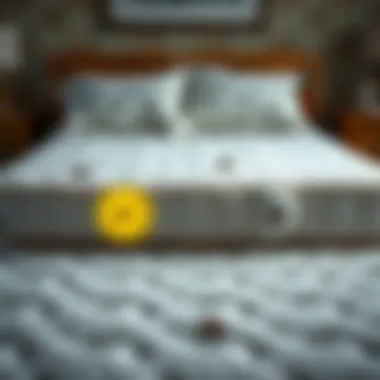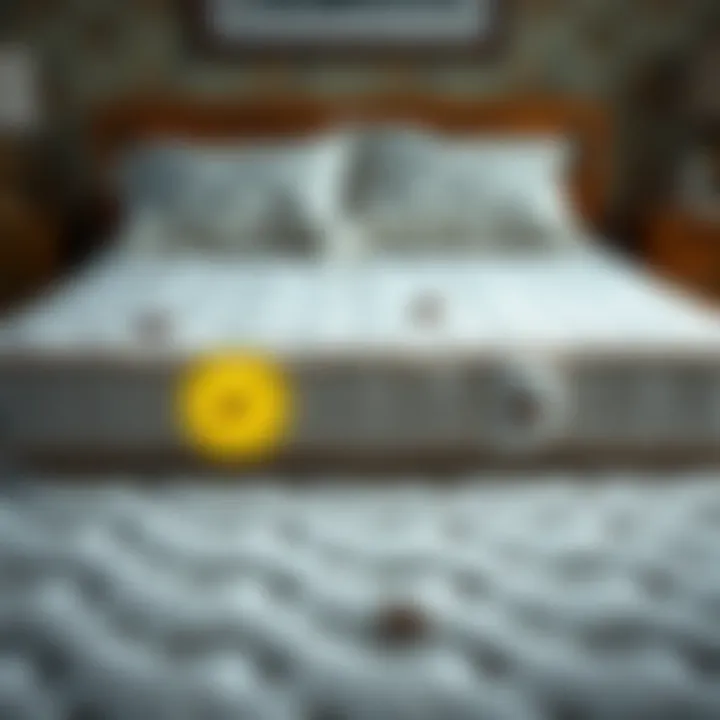Understanding Bed Bugs and Their Mattress Habits


Intro
Bed bugs are not just a nuisance; they can invade your peace of mind and your home. These tiny insects often hide in the most intimate confines of our lives, especially in our mattresses. Understanding how bed bugs operate, their habits, and behaviors can arm you with the information needed to prevent or combat an infestation. This article dives into the world of bed bugs, particularly their relationship with mattresses, providing a thorough exploration of everything from identification to effective prevention strategies.
Pest Identification
Common Household Pests
Bed bugs, scientifically known as Cimex lectularius, are among the most infamous pests invading homes. Recognizing them is the first step in tackling an infestation. These pests are small, usually about the size of an apple seed—flat and oval-shaped with a reddish-brown color. Unlike cockroaches or ants, bed bugs are stealthy. They don’t scurry across floors, rather they remain tucked away in dark corners and seams, particularly in mattresses and linens.
Signs of Infestation
Knowing the signs of a bed bug infestation is crucial. Look for the following indicators:
- Bite marks: Small, red welts on the skin, usually found in a line or cluster.
- Fecal stains: Tiny dark spots on sheets or mattress seams—this is bed bug poop.
- Eggs and shells: These are about the size of a pinhead and are often found in hidden areas.
- Musty smell: A faint, unpleasant odor can arise from an infestation.
"Prevention is better than cure." This saying holds true with bed bugs; detecting them early can save you from extensive treatments and discomfort.
Prevention Methods
Environmental Modifications
Creating an environment less hospitable to bed bugs is vital. Here are some effective strategies:
- Declutter: Remove unnecessary items from your sleeping and living areas.
- Protect your mattress: Investing in bed bug-proof covers can act as a barrier.
- Seal cracks and crevices: Make it hard for bed bugs to find shelter by sealing potential hiding spots in walls and furniture.
Home Maintenance Tips
Regular maintenance can go a long way in keeping your home bed bug-free. Consider these tips:
- Frequent vacuuming: Pay special attention to mattresses, box springs, and surrounding areas.
- Launder bedding regularly: Washing sheets and pillowcases in hot water can kill off any lingering bugs.
- Inspect regularly: Periodically examine your mattresses, putting extra focus on seams and folds.
DIY Pest Control Solutions
Natural Remedies
Before reaching for harsh chemicals, some natural methods can deter bed bugs. Solutions such as diatomaceous earth or essential oils like lavender and tea tree can be effective. Sprinkling diatomaceous earth around your bed can desiccate bed bugs on contact.
DIY Traps and Barriers
Use household items creatively to trap or deter bed bugs:
- Homemade traps: Place double-sided tape around the legs of your bed. This can catch the bugs as they try to climb up.
- Clutter barriers: Keep items off the floor to reduce potential hiding spots.
For further information, consider visiting the following resources:
- Centers for Disease Control and Prevention
- Wikipedia on Bed Bugs
- Pest Control Strategies - Britannica
- Bed Bug Forum - Reddit
This article equips you with the necessary knowledge and tools to maintain a bed bug-free home.
Understanding Bed Bugs
When it comes to battling these unwanted house guests, knowing your enemy is half the battle. Understanding bed bugs is crucial for effective prevention and management. These pests aren’t just pesky; they can lead to a major headache for homeowners. In this article, we dive into the fascinating world of bed bugs, from their biology to their behavior. By grasping these concepts, readers can better protect their living space and enjoy a peaceful night's sleep.


Biology and Lifecycle of Bed Bugs
The bed bug is a small, elusive insect that often hides in mattresses, box springs, and crevices. An adult bed bug is typically about the size of an apple seed, reddish-brown, and flat, which allows it to easily slip into tight spots. The lifecycle of bed bugs is particularly noteworthy; from egg to adult, they go through several stages: egg, nymph, and adult.
- Egg Stage: A female will lay about 200 to 500 eggs over her lifetime, with each egg being a tiny speck, almost pin-sized, about 1 mm in length.
- Nymph Stage: After about a week, the eggs hatch into nymphs which look like mini versions of adults. They require a blood meal to molt and move to the next stage. This can happen up to five times!
- Adult Stage: Once they reach adulthood, they can live anywhere from a few months to over a year, depending on their environment and availability of food.
Bed bugs thrive in warm, human environments, specifically when they can easily access their primary food source—blood. Their adaptability and rapid reproduction make them challenging adversaries.
Behavior and Habits
Now let's tackle the habits of these pests. Bed bugs are nocturnal critters; they prefer to emerge at night when their unsuspecting hosts are fast asleep. Their bites can leave itchy welts, but many people don’t realize they have been bitten until they wake up.
Here are some key behaviors of bed bugs:
- Feeding: They take around 5-10 minutes to feed, injecting saliva into the host that can cause an allergic reaction.
- Hiding: During the day, they skedaddle to their hideouts—usually in seams of mattresses or cracks in furniture. This concealment protects them from human detection.
- Traveling: Interestingly, bed bugs are excellent hitchhikers. They can cling to luggage, clothing, and furniture, leading to infestations in homes that have never had a problem before.
How Bed Bugs Access Mattresses
Understanding the pathways through which bed bugs can enter mattresses is crucial in maintaining a safe and healthy sleep environment. Bed bugs, those pesky little creatures, tend to latch onto their unsuspecting hosts as they travel through our living spaces. Knowing these access points can help homeowners effectively minimize risk, preventing what can become a significant infestation if left unchecked. This section will explore the common ways bed bugs gain a foothold in bedding and cover the routes they may take within homes to ensure the alarm bells ring in a timely fashion.
Common Entry Points
Bed bugs are no strangers to stealth; they can slip through the tiniest of crevices. Recognizing where they might enter your mattress is key to staying one step ahead. Here are some of the common entry points you should consider:
- Seams and Zippers: The seams of a mattress are often where bed bugs like to hide. They can squeeze into the smallest openings between the fabric and the mattress core. Zippered mattresses may also provide an attractive entry point, especially if the zipper has any gaps.
- Furniture Cracks: Infestations often start in furniture. Bed bugs can easily hop onto the bed from a nearby infested nightstand or headboard. Those crevices and joints in furniture pieces can harbor these pests before they make their move to the mattress.
- Bed Frames: Wooden bed frames, especially those with a lot of connections and attachments, can serve as a prime real estate for bed bugs. Hiding in cracks or within slats provides the perfect cover for them before they jump onto your mattress.
- Linens and Bedding: Oftentimes, bed bugs hitch a ride on bedding that's been stored or laundered improperly. They can cling on to sheets, pillowcases, or blankets, sneaking into your mattress when it's time to rest.
- Travel Gear: If you've recently traveled, keep an eye on your luggage. Bed bugs are known to latch onto suitcases and bags, making their way into your home the moment you drop them on your bed.
Identifying these entry points is foundational to combating bed bugs before they can establish a presence within your bedding.
Infestation Routes Within Homes
Bed bugs don't simply appear out of nowhere. They have particular routes they navigate within a household, making it essential for homeowners to be vigilant. Here’s a structured view of how they typically move:
- Adjacent Rooms: Bed bugs are not bound by walls. They can crawl through outlets or even gaps in the flooring to reach adjoining rooms. An infestation can rapidly spread from one bedroom to another if not addressed quickly.
- Shared Walls: In multi-unit dwellings or apartments, bed bugs can travel through wall cavities. They easily travel between units, making it difficult for people living in close proximity to avoid them altogether.
- Common Areas: Bed bugs also thrive in common areas like living rooms and shared laundry rooms. If one household encounters an infestation, others connected through these spaces are at risk as well.
- Human Movement: Sometimes people unwittingly carry these pests from one place to another on shoes or clothing. This means regular checks upon returning home are prudent to avoid inadvertently providing entry for these unwelcome guests.
In essence, bed bugs are adept travelers, easily moving from one place to another, relying on human behavior and home design as mechanisms for spreading their numbers.
Signs of Bed Bug Infestation
When it comes to spotting bed bugs in your home, it’s vital not to overlook the signs of an infestation. Knowing these indicators helps homeowners take swift action before the situation spirals out of control. Early detection means lower treatment costs and less disruption to your living space. By understanding what to look for, you can ensure that your mattress remains a sanctuary rather than a breeding ground for these unwelcome pests.
Identifying Physical Evidence
Bites
Bed bug bites are often the first noticeable sign of an infestation. These itchy, red welts typically appear in a line or cluster, making them quite distinctive. When a bed bug bites, it injects an anesthetic that can mask the sensation, so individuals may not feel the bite immediately. The significance of bites lies in their ability to signal the presence of these pests while you sleep, often leading you toward further inspection of your mattress and sleeping environment. One particular aspect to note is that not everyone reacts to bites in the same way. Some may experience no discomfort at all, while others may have severe reactions, making awareness of the signs crucial. Having a visual reference to identify these bites can help in distinguishing between them and other insect bites, leading to quicker action.
Fecal Stains
Another telltale mark of a bed bug infestation is the presence of fecal stains. These are often small, dark spots resembling ink droplets and can be found on bedding, mattress seams, and even walls. The occurrence of these stains indicates that bed bugs have been feeding in the area, offering a reliable clue to their presence. One of the advantages of identifying fecal stains is that they remain even after the bugs have been removed, serving as a long-term indication of past infestations. When observed, it prompts immediate inspection and potential treatment steps, preventing any chance of re-infestation. However, they can be easily mistaken for other stains, so context and thorough investigation are necessary.
Molt Skins
As bed bugs mature, they shed their skins in a process known as molting. The presence of these skins is a strong indication of an established population. These clear, flaky remnants can often be found near their hiding spots, such as the seams and creases of mattresses or upholstered furniture. Identifying these molt skins is beneficial for establishing the magnitude of an infestation; finding several skins can indicate a significant problem. Unlike bites or fecal stains, these skins don’t hold any risk to health but serve as a silent reminder of the battle against these pests. It’s important to recognize that spotting molt skins can help in knowing how long an infestation has been present, allowing for better targeted treatment strategies.


Behavioral Indicators
In addition to physical evidence, watching for behavioral indicators can provide deeper insights into the presence of bed bugs. For instance, reports of waking up with unexplained itching or discomfort could signal a need to investigate further, especially if accompanied by the signs mentioned above. Pay attention to these subtle changes in behavior, as they can be as telling as the physical evidence in determining whether it’s time to take action against these persistent invaders.
Risks Associated with Infested Mattresses
Understanding the risks associated with infested mattresses is crucial for homeowners and households. Bed bugs don’t just invade your space; they bring a whole list of potential threats that can disrupt your life. Misunderstanding the severity of an infestation can lead to delayed actions and increased problems that could have easily been避けられました.
Health Implications
The health implications of bed bug infestations are significant and often underappreciated. First and foremost, bed bug bites can lead to a range of skin reactions. Some people experience mild irritation, while others can suffer from severe allergic reactions, including intense itching and swelling. You might also find yourself scratching those bites, which can result in open sores and potential infection. In some cases, constant scratching can cause secondary skin infections that may necessitate medical interventions.
Moreover, the psychological effects should not be ignored. The presence of bed bugs can instill a sense of anxiety, fear, and even insomnia in those affected. The mere thought of bugs crawling on you while you sleep contributes to long-lasting stress, and it can turn your sanctuary into a source of discomfort and dread.
Impact on Sleep Quality
Sleep quality takes a serious hit when bed bugs are in the picture. When you know that there's a chance of these critters crawling about, it can be hard to relax. Worrying about being bitten often keeps homeowners tossing and turning all night. When your mind is occupied with thoughts of bugs, how can you achieve restful sleep?
Inadequate sleep can lead to a decline in overall health and wellness, contributing to fatigue, decreased focus, and irritability. This becomes a vicious cycle; lack of sleep raises stress levels, which may make one more susceptible to health problems, further complicating matters.
"A stitch in time saves nine." It’s wise to take preventive measures and act quickly if you suspect an infestation.
Preventing Bed Bugs in Mattresses
Preventing bed bugs in mattresses is both a necessity and a wise investment for any household. These pests can invade your sleeping space with surprising ease, making the prevention of infestations crucial. A mattress serves as a safe haven for these critters; thus, preventing their entry not only protects your bedding but also maintains the integrity of your home environment.
There are several effective methods for keeping bed bugs at bay, and understanding their importance can save you a lot of headaches down the road. Using protective covers and adhering to regular cleaning practices can significantly decrease the likelihood of an infestation. By taking proactive steps, you create a physical barrier and a clean slate that discourages bed bugs from setting up shop.
Protective Covers
Using protective covers is a frontline defense against the intrusion of bed bugs into your mattress. These covers are specially designed to encase the mattress entirely, creating an almost impenetrable fortress for pests. One key characteristic of these covers is the zipper, which is often designed with a fine tooth to keep even the smallest insects at bay.
Why are protective covers so popular? Mainly, they not only prevent bed bugs from entering the mattress but also trap any bugs already within. This means that if a mattress is already infested, the covers can help to contain the problem while you work on eradicating it. The unique feature here is that many protective covers are also waterproof, adding an extra layer of protection against spills and allergens. However, it’s vital to select high-quality, durable materials, otherwise, the cover may not perform as expected.
Regular Cleaning Practices
Regular cleaning practices are your allies in the battle against bed bugs, and it’s no secret they can’t thrive in a clean environment. Implementing consistent cleaning habits can drastically reduce the risk of infestation.
Vacuuming
One specific aspect of regular cleaning is vacuuming. This is a straightforward yet effective practice that can greatly contribute to the overall goal of a bed-bug-free mattress. Vacuuming is popular for its ability to capture not just bed bugs but also their eggs and droppings, making it an incredibly useful tool.
The key characteristic of vacuuming is its accessibility; nearly everyone has a vacuum cleaner at home. When used correctly, vacuuming can target not just the mattress but also the surrounding area, like the bed frame and nearby furniture. A unique feature of vacuuming is the option to use specialized attachments that can reach those tricky crevices where bugs like to hide. While vacuuming is generally beneficial, it’s not a stand-alone solution. Regularly changing the vacuum bag or emptying the canister is critical, as it helps prevent any potential re-infestation from occurring.
Washing Bedding
Another vital cleaning practice is washing bedding. Frequent washing of sheets, pillowcases, and blanket is essential not only for personal hygiene but also to eliminate bed bugs lurking in your bed linens. The key characteristic of washing bedding is the high temperatures involved; hot water and dryer cycles can kill bed bugs at all life stages. This makes washing a beneficial and necessary choice in the fight against infestations.
The unique advantage of washing bedding often is that it encourages a habit of awareness; checking for signs of infestations can naturally become part of your routine. However, the disadvantage could be the time and effort it takes, especially for larger households.
Implementing protective covers and regular cleaning practices can make all the difference in ensuring a bed-bug-free mattress.
By making these simple adjustments in daily routines, you can create a healthy sleeping environment, free of the unwanted presence of bed bugs.


Treatment Options for Infestations
Finding yourself grappling with a bed bug infestation can indeed feel overwhelming. Fortunately, there are various strategies available for tackling these pests lurking in your mattress and surrounding areas. Tackling the problem promptly is crucial, as it becomes increasingly difficult to manage a larger infestation. This segment will explore the options for treatment, highlighting both professional and do-it-yourself (DIY) methods.
Professional Pest Control Services
When infestations spiral out of control, turning to a professional pest control service often is your best bet. Experts in the field have the training and tools to effectively deal with bed bugs. Their approach typically includes a comprehensive inspection followed by targeted treatments that address both adult bugs and eggs.
Notably, professional services employ techniques that go beyond what an average homeowner can achieve on their own. For instance, they may use specialized equipment, such as thermal foggers or insecticide sprayers, ensuring they reach every nook and cranny where bed bugs might hide.
It's vital to choose a reputable company that uses products approved by environmental agencies. Consumer trust is paramount in this field, and the right service will not only eliminate the immediate issue but also provide guidance on prevention to keep these undesirable guests at bay.
DIY Treatment Methods
If you're the hands-on type or wish to take immediate action before seeking professional help, several DIY treatment methods exist. However, a word of caution: persistence and a multi-faceted approach often yield the best results.
Heat Treatment
Heat treatment stands out as a popular DIY method. The premise is straightforward: bed bugs and their eggs die at temperatures around 118°F (48°C) and above. Homeowners can utilize devices like portable heaters that elevate room temperatures or use steam cleaners for bedding and furniture.
One of the key characteristics of heat treatment is its thoroughness. It can penetrate mattress layers and other furniture pieces where bed bugs hide. An added advantage is that this method is chemical-free, making it a safer choice for households with children or pets. However, it requires care. Improper use of heat can damage your belongings or cause fires. Always follow safety guidelines and keep an eye on the conditions.
Chemical Solutions
Chemical solutions are another avenue worth considering. These include insecticides specifically designed for bed bug extermination. Many products are available over the counter, but not all are effective or safe for home use.
The main advantage of chemical treatments lies in their ease of application; they often come in ready-to-use bottles or sprays and target bugs directly. However, there’s a notable concern regarding their safety and potential toxicity, especially if proper precautions aren’t taken. Users must adhere stringently to the label instructions to minimize any health risks.
Additionally, certain chemical solutions may not always yield long-term results, particularly against resistant bed bug strains, leading to the need for repeated applications. Thus, while they can serve as a quick fix, they might not be entirely foolproof.
Remember: The best offense is a good defense. Staying vigilant, inspecting regularly, and maintaining cleanliness are paramount in preventing infestations from taking hold.
Long-term Management Strategies
Addressing the issue of bed bug infestations requires not just immediate action, but also a long-term commitment to strategies that prevent their return. It's crucial to look at this as an ongoing plan rather than a one-time fix. The benefits of establishing a robust management strategy are manifold. It allows homeowners to not only address current problems but also reduces the likelihood of future infestations.
Benefits of Long-term Management:
- Sustained Prevention: Consistent practices can make your home less inviting for bed bugs, decreasing their chances of settling in.
- Cost-Effective Solutions: Investing in long-term strategies can save you money on expensive pest control services later.
- Enhanced Peace of Mind: Knowing you're taking active steps can alleviate anxiety surrounding potential infestations.
When considering what elements should be included in a long-term management strategy, it can be helpful to think in terms of regular maintenance and proactive measures.
Monitoring and Inspection
A critical component of long-term management is continuous monitoring and inspection of your living space. Those pests can be sneaky, and they often thrive without detection until it's too late. Monitoring should be a routine activity integrated into your cleaning schedules.
- Be Proactive: Regularly check sleeping areas, especially seams and folds of mattresses, as these are prime hiding spots.
- Use Traps: Consider placing bed bug interceptors under your bed legs or in other strategic locations. These devices can help catch bed bugs as they attempt to move about.
Performing inspections doesn't require expertise. Simple visual checks can go a long way. Learning to spot the signs of an infestation early can save you from a major headache down the road. A dark and damp environment, especially when paired with humid conditions, can be a breeding ground for bed bugs. Watchout for those areas!
"Early detection is not only the best way to handle an infestation but also the simplest."
Educating Household Members
No bed bug management strategy can be truly effective without the involvement of everyone in the household. Educating all members about bed bugs and how they operate is key. Ensure that everyone knows how to recognize early signs of bed bugs, such as itchy bites or small blood stains on sheets.
Elements to Cover in Your Education Program:
- Identification: Provide clear descriptions of what bed bugs look like, including their young, as they can be very small.
- Preventive Measures: Teach everyone how to inspect shared spaces, such as the couch or guest rooms, especially after visitors. Encourage informality; if something seems off, it’s essential to speak up.
- Safe Travel Practices: Discuss how to check hotel rooms before settling in, including lifting the mattress slightly and checking for any signs of life.
Educating household members creates a united front in the fight against these pests. When everyone is informed and alert, you significantly lower the risk of bed bugs taking up residence in your home again. Long-term management is about teamwork, and awareness is your first line of defense.















